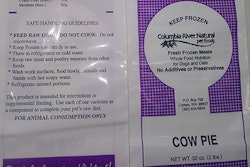
Scientists found several trace minerals in dog food at concentrations that exceeded equivalent average human daily intakes. For example, maintenance-level daily servings of one dog food contained approximately 38 times the relative quantity of aluminum that humans consume on average in a day. Chromium, molybdenum, aluminum and other minerals occur in tiny amounts in both human and pet food. Scientists refer to these substances as ultra-trace minerals.
However, the researchers could not conclude if those ultra-trace minerals might actually pose a threat to dogs’ health. Previous research has not established dangerous canine consumption amounts of those chemicals, although some cause problems in high doses in other animals, including humans.
“Chromium, molybdenum and aluminum concentrations in all of the dog foods were at levels that would be considered above average human daily consumption on a caloric basis…” wrote the researchers in Veterinary Medicine: Research and Reports. “The exact reasons for this finding are unclear but may have to do with the slightly higher metabolic demands of dogs than humans who require fewer calories per kilogram body weight and/or the modest differences in common food ingredients used in the dog food industry compared to foods consumed by humans.”
For example, human foods tend to contain more processed ingredients, such as corn starch, white rice, and bleached flour, than dog foods, wrote the researchers. Processing can reduce the quantity of trace minerals. Unrefined ingredients in pet foods may lead to potentially higher exposure to aluminum, chromium and other trace minerals.
Research on trace mineral concentrations in dog food
Scientists at Cornell University College of Veterinary Medicine analyzed the levels of nickel, silica, aluminum, chromium and molybdenum in dog food. They tested 49 over-the-counter dry dog foods meant for healthy dogs at all life stages. The dog foods came from local and national pet food retailers, grocery stores and Cornell’s Veterinary Medical Center.
The researchers converted their dog food results to consumption per megacalorie, so that they could compare them to typical chronic human consumption levels established by the World Health Organization (WHO). The scientists assessed the levels of the mineral in dog food against WHO toxic consumption information.
Aluminum, chromium and molybdenum concentrations exceeded the average daily dose for humans.
- The median chromium concentration in dog food was approximately 30-times higher than daily human intake.
- The highest molybdenum concentration reached approximately 15 times human consumption level. All 49 dog foods contained more molybdenum than the amount scientists estimated that dogs needed nutritionally.
- Aluminum concentrations in 46 dog foods exceeded equivalent daily human intake.
The researchers didn’t find levels of nickel and silica that greatly exceeded relative human daily consumption.

















